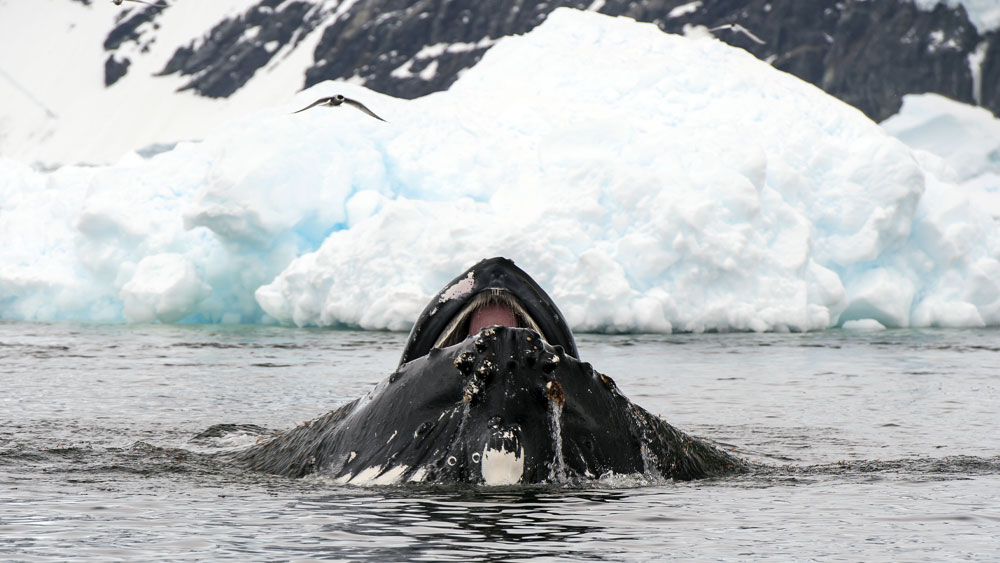Baleen whales (suborder Mysticeti) are amazing filter-feeding mammals of the sea. They belong to a group called the Cetacea. Evolutionists suggest they were mammals that “returned” to the sea about 60 million years ago in search of food. “But there remains intense debate about how and when cetacean ancestors returned fully to the water.”1 Now, new research that throws reptiles into that story will produce even more debate material while confirming creation and the Flood.
Baleen whales are easily recognized by their characteristic sheet of over 300 keratinized baleen plates in their mouth. What was the origin of these comb-like structures designed to strain krill? In 2018, Science magazine reported that a fossil suggested some toothless whale ancestors may have sucked up their food before evolving baleen plates.
Now, a rare fossil offers an answer: Ancient whales likely first lost their teeth and suctioned up their food, as salmon and some other fish do, then evolved baleen. Other recent research had suggested the transition from teeth to baleen involved a slow, seamless transformation from one to the other.2 (Emphasis added.)
This is nothing more than what is called a just-so story. Five years later, the subject of baleen origin is still challenging, with nine authors stating, “The origin of baleen in stem mysticetes is contentious and researchers suggested several interpretations of the transition from raptorial feeding with teeth as in stem mysticetes to baleen-assisted filter feeding as in modern mysticetes.”3
Recently, a new fossil in China revealed “that a group of reptiles were [sic] already using whale-like filter feeding 250 million years ago.”4
In a BMC Ecology and Evolution paper, the authors stated, “Here we present compelling evidence for filter feeding in one of the earliest marine reptiles of the Mesozoic, Hupehsuchus nanchangensis...“3 Paleontologists are thrilled because these marine animals had “baleen whale-like structures to filter food items as it swam forward.”4 The structures were designed with keratin strips and notches and grooves along the jaws instead of teeth.
The fossil record shows two groups of animals (reptiles and mammals) both equipped with baleen that efficiently strains tiny crustacea. Those who reject Genesis and creation posit baleen independently evolved in these two very different groups.
Where is evolution theory in this discovery? Evolutionists appeal to the unscientific idea of convergence,5 the development of similar body traits between unrelated creatures. In this case, they believe that the skull morphology of modern oceanic mammals and that of an “early” marine reptile supposedly arose independently in different evolutionary lineages.
The snout of Hupehsuchus is highly convergent with modern baleen whales, as shown in a morphometric analysis including 130 modern aquatic amniotes. Convergences in the snout include the unfused upper jaw, specialized intermediate space in the divided premaxilla and grooves around the labial margin.3
Evolutionists see the similarity of the snout and unfused upper jaw but will never be able to find or even imagine a common ancestor with these traits. So, convergence to the rescue. However, this similarity is actually evidence for creation.
Creationists maintain the skull morphology is similar in Hupehsuchus and baleen whales not because they evolved convergently, but because the Lord Jesus designed both reptiles and whales to filter feed. Fang et al stated, “…Hupehsuchus probably employed continuous ram filter feeding as in extant bowhead and right whales.”3
Isn’t it interesting that we find the same filter feeding mechanisms in both an “ancient” reptile fossil and present-day whales? Evolutionary theory offers an unsatisfying explanation for this similarity, calling on chance and time to somehow create baleen. Our Creator, however, demonstrates His creative power and wisdom to provide the filter feeding mechanisms in both reptiles and whales. Creationists know that this is what the Lord Jesus intended. As Luke records in the book of Acts, it was “...the living God, which made heaven, and earth, and the sea, and all things that are therein”. (Acts 14:15)
References
- Research Posts. Whales and Hippos Evolved Water-Ready Skin Independently. American Museum of Natural History. Posted on amnh.org April 1, 2021, accessed August 20, 2023.
- Reese, A. How ancient whales lost their teeth—and turned into the world's biggest living filters. Science.org. Posted on science.org October 18, 2018, accessed August 20, 2023.
- Fang, et al. 2023. First filter feeding in the Early Triassic: cranial morphological convergence between Hupehsuchus and baleen whales. BMC Ecology and Evolution. 23(36).
- University of Bristol. Whale like filter-feeding discovered in prehistoric marine reptile. Phys.org. Posted on phys.org August 7, 2023, accessed August 20, 2023.
- Guliuzza, R. Major Evolutionary Blunders: Convergent Evolution Is a Seductive Intellectual Swindle. Acts & Facts. 46 (3).
- Tomkins, J. and T. Clarey. Whale Fossils Confirm Post-Flood Boundary. Acts & Facts. 48 (12).
* Dr. Sherwin is science news writer at the Institute for Creation Research. He earned an M.A. in zoology from the University of Northern Colorado and received an Honorary Doctorate of Science from Pensacola Christian College.














